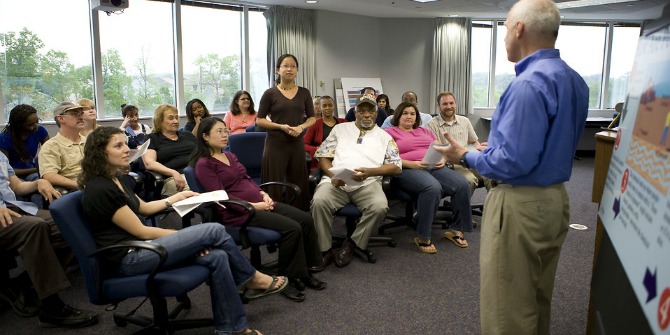
It’s 4:45 PM on a Friday, you’re about to head home, and then your phone buzzes. You look down to see a text from a previous employee that hasn’t been in contact since departing several months ago (sans a LinkedIn request). He says he just wants to “catch up”, but you suspect another angle. Ten minutes into a coffee meeting the next week and you get it — he wants to come back to the company. A host of questions go through your mind: Is this normal? Why did you leave in the first place? Why do you want to come back? Will you perform the same?
Research on “boomerang” employment is still nascent, to be sure, but it can nevertheless tell us quite a bit about the phenomenon. Here’s a primer on that research:
To start, situations like the one proposed in the first paragraph are quite common in today’s business environment (for examples, see here and here). Employees switch jobs quite frequently and, unsurprisingly, many are open to returning to a former employer. In fact, recent survey estimates suggest that over 40 per cent of employees are willing to return to a previous employer, with 85 per cent of HR professionals saying they have received applications from former employees. On the other side, 76 per cent of employers say they are more open to hiring previous employees than in the past; many companies even manage alumni networks to help stay in touch (for one example, see here).
Optimists argue that boomerangs can add significant value because they know what they’re getting into and require lower ramp up time; have acquired some useful skills and social capital; and will be more committed the second time around (they know firsthand the grass isn’t greener on the other side). Cynics, on the other hand, see traitors or underperformers who couldn’t cut it at their last job. Moreover, some fear that re-hiring former employees will set a bad precedent (the “If I let one person come back, employees will have no reason to stay” logic).
Abbie Shipp and her colleagues (along with an author of this post) recently published a rigorous examination of the reasons why employees leave and then decide to come back. Their findings suggest that boomerangs, compared to a group of alumni who had no interest in returning, were more likely to leave due to a negative personal shock (e.g., taking care of a suddenly ill family member) or a lucrative alternative offer; they were also more likely to stay in the same industry or leave the workforce altogether during their time away (versus leaving for a job in a different industry). The “never return” alums, not surprisingly, were more likely to leave due to growing dissatisfaction. Interestingly, the boomerang employees, on average, had shorter first-term tenures than the “never returns”. So, when an employee stays a long time and then leaves , s/he might be pretty sure it’s over, whereas relative newcomers might be more susceptible to the mistakes lamented by Joni Mitchell (“You don’t know what you’ve got ‘til it’s gone…”).
That information can be useful if you’re trying to cultivate former employees as future staffing options. Retrospectively, it gives you an idea of which employees are most likely to return; looking forward, it guides your focus toward ensuring that if your employees do leave, they do so in ways that permit a way back.
Yet, importantly, that research was unable to address an important follow-up: What factors actually predict a boomerang’s return performance?
Our research team (including Brian Swider and Joseph Liu) recently published a study that examined that exact question. We extensively reviewed the careers literature, spoke with numerous stakeholders, then built a model of factors we believed should predict boomerangs’ return performance. Using a sample from the professional sports industry (which gave us standardised, objective performance data for employees), we tested our presumptions. Here are five big take-aways:
- Prior performance is a good predictor of future performance. We get it — this is hardly groundbreaking. Consider this your reminder: It might be tempting to imagine that a really nice, but mediocre performer “finally figured it out”, but beware. As a former employer you should be privy to performance data that no one else has about the employee and we suggest you leverage that in your decision-making.
- Rich interim experiences matter. Beyond performance at your company, consider what the employee has been doing during their time away and whether that meaningfully adds to your organisation. Employees with more applicable experience performed better in our sample.
- Time away matters, too. Careers are essentially buckets of learning, unlearning/forgetting, and sometimes re-learning. The longer a boomerang employee is away from an employer, the more his/her performance suffers (even controlling for age effects in our sample). Granted, the magnitude of the time away “penalty” does diminish some at longer time away periods (performance does not decrease linearly as time away increases), but the relationship is still generally negative.
- Coming back to familiar surroundings is helpful. A lot can happen while a boomerang was gone, so even just coming back to the same work location can be associated with higher performance.
- Think about who broke up with whom and, separately, who calls to get back together. Employees that are pushed out in their original tenure perform worse than those who leave on their own. Also, employees that are recruited to rejoin the organisation (versus those that reach out on their own) perform better. Admittedly, this is also quite straightforward since organisations are unlikely to force out their best employees and, likewise, more likely to recruit the best ones back. Nevertheless, we identified cases on both sides of the equation, so clearly not all organisations act on this intuition!
Now, we should note a few caveats. First, we believe our sample has a lot of utility in other industries, but you nevertheless need to be mindful of which assumptions are likely to hold for your context. So, consider our suggestions a starting point while you build your own company-specific model (using data).
Second, don’t forget cost. Employees are motivated to leave and try new things for myriad reasons. Some are intrinsic, whereas others are clearly more extrinsic. To the latter, money is a big one—it’s just easier to get significant raises by switching companies sometimes. So, a safe starting assumption, we presume, is that boomerangs will want to come back at a higher starting salary than they left with (and if they don’t, paradoxically, you have to wonder why!). Yet, labour economists estimate that companies often overpay when hiring from the external market (see here), so make sure you’re actually getting more for your money (in terms of knowledge, skills, social capital, etc.).
Finally, our study indicates variables that explain significant variance in return performance, but not ALL of the variance. In other words, there are exceptions to the rules. In some cases, you may know about extenuating circumstances that explain away some concerns (perhaps a prospective boomerang’s performance suffered immediately after a traumatic family event, but was solid beforehand). You should be thoughtful and compassionate toward these situations. That said, we warn that humans — and especially those in hiring positions — are susceptible to subconscious biases that can lead them to overemphasise intuition. For example, some of us focus on the good in prior relationships (“rosy retrospection”) or have a tendency to want to recoup our lost investments in old relationships, even bad ones. These can be pitfalls when evaluating prospective boomerangs.
Future research will undoubtedly shed more insight on the boomerang phenomenon, but we hope this gives you a basic primer as you build your own strategy. We believe that the companies that learn to best leverage this increasingly common applicant pool will be well-positioned to realise a competitive human resource advantage.
♣♣♣
Notes:
- This blog post is based on the authors’ paper Employees on the rebound: Extending the careers literature to include boomerang employment, co-authored with Brian Swider and Joseph Liu, Journal of Applied Psychology, 102(6), 890-909 (http://dx.doi.org/10.1037/apl0000200)
- The post gives the views of its authors, not the position of LSE Business Review or the London School of Economics.
- Featured image credit: Corporation, by Raphael Koh on Unsplash, under a CC0 licence
- Before commenting, please read our Comment Policy.
 Brad Harris is an assistant professor at the Neeley School of Business at Texas Christian University, where he teaches undergraduate and graduate courses in leadership and human resources management. Brad’s research focuses primarily on teams, leadership, and employee transition into/out of organisations. His coauthored book (with Bradley Kirkman), “3D Team Leadership: A New Approach for Complex Teams” (Stanford), will be available this summer.
Brad Harris is an assistant professor at the Neeley School of Business at Texas Christian University, where he teaches undergraduate and graduate courses in leadership and human resources management. Brad’s research focuses primarily on teams, leadership, and employee transition into/out of organisations. His coauthored book (with Bradley Kirkman), “3D Team Leadership: A New Approach for Complex Teams” (Stanford), will be available this summer.
 Richard Gardner is an assistant professor in the Lee Business School at the University of Nevada, Las Vegas. He received his PhD in management from Texas A&M University. His research focuses on counterproductive behaviours, employee socialisation, and identification.
Richard Gardner is an assistant professor in the Lee Business School at the University of Nevada, Las Vegas. He received his PhD in management from Texas A&M University. His research focuses on counterproductive behaviours, employee socialisation, and identification.





